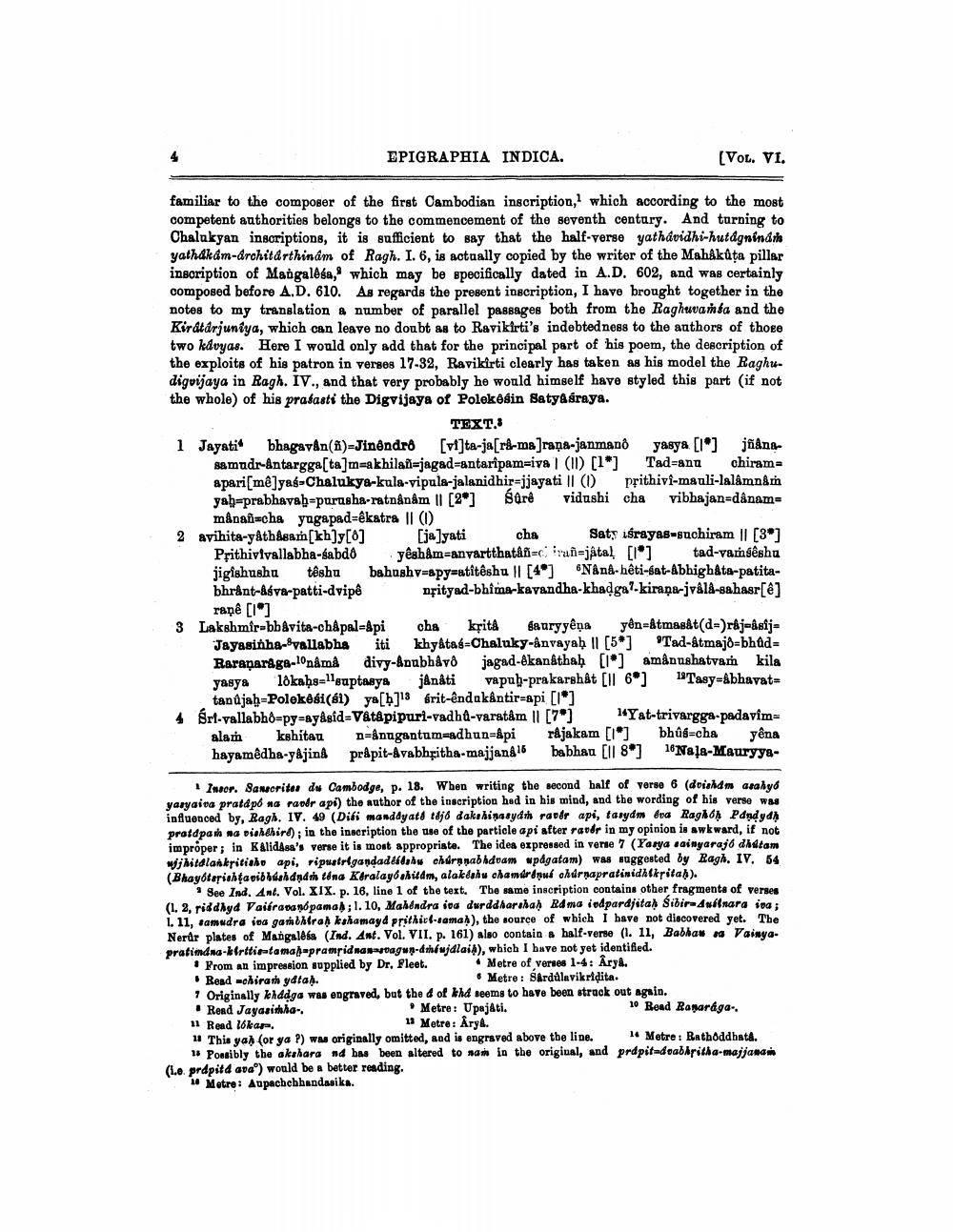________________
EPIGRAPHIA INDICA.
(Vol. VI.
familiar to the composer of the first Cambodian inscription, which according to the most competent authorities belongs to the commencement of the seventh century. And turning to Chalukyan inscriptions, it is sufficient to say that the half-verse yathavidhi-hutágnindth yathdkám-Architarthinam of Ragh. I. 6, is actually copied by the writer of the MahAkūta pillar inscription of Mangalêsa, which may be specifically dated in A.D. 602, and was certainly composed before A.D. 610. As regards the present inscription, I have brought together in the notes to my translation & number of parallel passages both from the Raghuvanta and the Kirátárjuniya, which can leave no doubt as to Ravikirti's indebtedness to the authors of those two kávyas. Here I would only add that for the principal part of his poem, the description of the exploits of his patron in verses 17-32, Ravikirti clearly has taken as his model the Raghudigvijaya in Ragh. IV., and that very probably he would himself have styled this part (if not the whole) of his prasasti the Digvijaya of Polekêsin Satyasraya.
TEXT.: 1 Jayati bhagavån()-Jinêndro [vi]ta-ja[rå-ma]rana-janmanÔ yasya [1] jñana
samudr-Antargga[ta]m-akhilati-jagad=antaripam=iva (II) [1] Tad=anu chiramapari[m@]yas-Chalukya-kula-vipula-jalanidhir-jjayati || (1) prithivi-mauli-lalámná yab-prabhavab=purusha-ratnanam [28] Soré vidushi cha vibhajan-dâname
manafecha yogapad=ékatra II (1) 2 avihita-yAthleam(kh]y[0] [ja]yati cha Saty śrayas-suchiram || [3]
Prithivivallabha-labd yesh&m=anvartthatát=craft=jAtal [I] tad-vamsêshu jigishushu têshu bahushv=spy=atitêshu || [4] Nând-hêti-fat-Abhigh&ta-patitabhrant-Akva-patti-dvipê nfityad-bhima-kavandha-khadga?-kirana-jvåld-sahasr[è]
ranê [1] 3 Lakshmir-bb&vita-chapal-Api cha ksitá Sauryyêņa yên-atmas&t(da)ráj-keija
Jayasinha-vallabha iti khy&tag=Chaluky-&nvayah 11 [5] "Tad-Atmajd bhad - Raranaraga-lonama divy-&nubhavð jagad-ekanathah [1] amanushatvan kila yanya lokahs-laptasys jAnåti vapub-prakarshật [ll 6°) Tasy-Abhavat
tanajah-Polekesi(61) ya[b]18 brit-êndukåntir-api [l*] 4 Srl-vallabhô=py-ay&sid=V&tâpipuri-vadhd-varatám 11 [7") "Yat-trivargga-padavim
alam kshitau n-inngantum=adhun=&pi råjakam [1] bh08-cha yêna hayamêdha-yajin pràpit-Avabhitha-majjank16 babhan [Il 8] 16Nala-Mauryya
Insor. Savorites du Cambodge, p. 18. When writing the second half of verso 6 (doiald. dalys yaryaina pratdp ng raotr api) the author of the inscription had in his mind, and the wording of his verse was influenced by, Ragh. IV. 49 (Difi manddy atd t86 dakshinasydth raodr api, tasydm dra Raghon Pdpd ydh profdpado na vishdhird); in the inscription the 18e of the particle api sfter rande in my opinion is awkward, if not improper; in Kalidasa's verse it is most appropriate. The idea expressed in vente 7 (Yarya saingarajo dhitam wij hitslankritiaho api, ripustrigandad lithu chúrnnab hdtam wpdgatam) was suggested by Ragh. IV. 54 (Bhaytarishta vibbushdndoh tina Kdralayo ehitdm, alakdaku chandrui chdrnapratisid krital).
See Ind. Ant. Vol. XIX. p. 16, line 1 of the text. The same inscription contains other fragments of verses (1.2, riddhyd Vairavano pamal; 1. 10, Mahindra los durddharahah Rdna iedpardjita) Sibir dinara ing; 1. 11, samudra ina gambaran kahamayd prithich-ramal), the source of which I have not discovered yet. The Nerdr plates of Mangallis (Ind. Ant. Vol. VII. p. 161) also contain a half-verse (1. 11, Babhau . Vaingapratimdna-kfritiratamal-pramsidnapytagun-dhinjalail), which I have not yet identified. From an impression supplied by Dr. Fleet.
Metre of versea 1-4: Arya. Read achirat ydtah.
Metre : Sårdûlavikridita. * Originally khddga was engraved, but the d of khd seems to have been strack out again. Read Jayasitha.. Metre: Upajati.
10 Road Ragaraga.. 11 Read 16kar.
11 Metre: Aryl. 11 This ya) (or ya P) wm originally omitted, and is engraved above the line. " Metre: Rathoddhata.
* Possibly the akshara nd has been altered to nam in the original, and prdpitadoabhritha-majjamasis (1.6. prdpitd ava') would be a better reading.
Metre: Aupachebbandasika.




